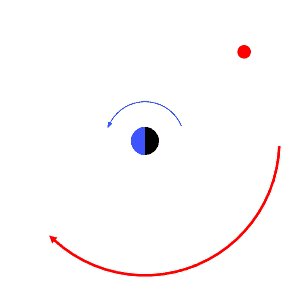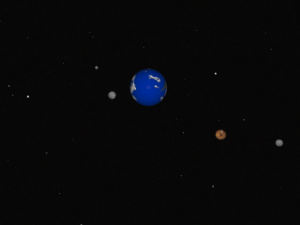Retrograde and prograde motion facts for kids
Retrograde motion in astronomy means an object is moving or spinning in the opposite direction compared to its main object. Think of it like a car going backward on a road where all other cars are going forward. The main object is usually a planet for a moon, or the Sun for a planet.
When an object moves or spins in the same direction as its main object, it's called prograde motion or direct motion. Most things in space move in a prograde way.
In our Solar System, almost all planets and most other objects orbit the Sun in a prograde direction. This means they go around the Sun the same way the Sun spins. If you looked down from above the Sun's north pole, they would all move counterclockwise.
Most planets also spin on their own axis in a prograde direction. The only exceptions are Venus and Uranus, which spin backward! Most natural satellites (moons) also orbit their planets in a prograde way.
Scientists believe that most retrograde moons were not formed with their planets. Instead, they were likely captured by the planet's gravity later on.
Contents
How Celestial Systems Form
When a galaxy or a planetary system first forms, its material usually flattens into a disk shape. Most of this material then orbits and spins in the same direction. This happens because of something called the conservation of angular momentum. It's like a spinning ice skater who pulls their arms in and spins faster.
In 2010, scientists found some planets called "hot Jupiters" that had backward orbits. This made them rethink some ideas about how planetary systems form. It's possible that stars and planets don't always form alone. They might form in groups of stars called star clusters. If a young planet's disk of material bumps into or takes material from a nearby gas cloud, it could cause the disk and its planets to move in a retrograde direction.
How We Measure Motion
Orbital Inclination
An object's inclination tells us if its orbit is prograde or retrograde. Inclination is the angle between an object's orbital path and a reference plane. For planets in our Solar System, we measure this angle from Earth's orbital plane around the Sun, called the ecliptic plane. For moons, we measure it from the equator of the planet they orbit.
- If the angle is between 0 and 90 degrees, the object is orbiting in the same direction as the main object. This is prograde.
- If the angle is exactly 90 degrees, the orbit is straight up and down. It's neither prograde nor retrograde.
- If the angle is between 90 and 180 degrees, the object is in a retrograde orbit. It's going the opposite way.
Axial Tilt
An object's axial tilt tells us if its rotation (spin) is prograde or retrograde. Axial tilt is the angle between an object's spin axis and a line straight up from its orbital plane.
- If the axial tilt is up to 90 degrees, the object is spinning in the same direction as its orbit. This is prograde.
- If the axial tilt is exactly 90 degrees, the object is spinning on its side. It's neither prograde nor retrograde.
- If the axial tilt is between 90 and 180 degrees, the object is spinning in the opposite direction to its orbit. This is retrograde.
Scientists define the north pole of any planet or moon in the Solar System as the pole that points towards the same part of space as Earth's north pole.
Solar System Objects
Planets
All eight planets in our Solar System orbit the Sun in a prograde direction. This means they all go counterclockwise when seen from above the Sun's north pole.
Six of these planets also spin on their own axis in the same prograde direction. The two exceptions are Venus and Uranus.
- Venus has an axial tilt of 177 degrees. This means it spins almost exactly backward compared to its orbit. Scientists think Venus probably started spinning fast and prograde, like other planets. But because it's so close to the Sun and has a thick atmosphere, special forces called "tides" slowed its spin and eventually made it go backward.
- Uranus has an axial tilt of about 97.77 degrees. This means it spins almost completely on its side! Scientists aren't sure why, but a popular idea is that a very large object, maybe the size of Earth, crashed into Uranus a long time ago. This huge crash could have knocked Uranus onto its side.
Dwarf Planets
All known dwarf planets orbit the Sun in a prograde direction. However, some of them spin backward. Pluto is one example; its axial tilt is about 120 degrees. Pluto and its largest moon, Charon, are "tidally locked," meaning they always show the same face to each other. Scientists think Pluto's moon system might have formed after a giant collision.
Natural Satellites and Rings
If a moon forms from the same material as its planet, it will usually orbit the planet in the same direction the planet spins. These are called regular moons.
Sometimes, an object forms somewhere else and later gets caught by a planet's gravity. These are called irregular moons. They can end up in either a prograde or retrograde orbit, depending on how they approach the planet.
In our Solar System, many small, asteroid-sized moons have retrograde orbits. But almost all the large moons, except Triton (Neptune's biggest moon), have prograde orbits. The particles in Saturn's Phoebe ring are thought to be in a retrograde orbit because they came from the irregular moon Phoebe.
Triton is the only large retrograde moon that is close enough to its planet (Neptune) for tidal forces to affect it a lot. These forces are slowly pulling Triton closer to Neptune, and eventually, it might crash into the planet. Other retrograde moons are too far away for these forces to matter much.
Asteroids
Most Asteroids orbit the Sun in a prograde direction. Only a few dozen asteroids are known to have retrograde orbits. Some of these might be old, "burnt-out" comets. Others might have gotten their backward orbits because of gravity from Jupiter.
Scientists have found that most small moons orbiting asteroids also move in the same direction as the asteroid spins.
Comets
Comets that come from the distant Oort cloud are much more likely to have retrograde orbits than asteroids. Halley's Comet is a famous example of a comet with a retrograde orbit around the Sun.
Kuiper Belt Objects
Most objects in the Kuiper belt have prograde orbits around the Sun. However, a few have been found with retrograde orbits. These include 2008 KV42, (471325) 2011 KT19, (342842) 2008 YB3, (468861) 2013 LU28 and 2011 MM4. These objects have very tilted orbits, often between 100 and 125 degrees.
Meteoroids
Meteoroids that are in a retrograde orbit around the Sun hit Earth much faster than prograde meteoroids. This means they are more likely to burn up in our atmosphere and create bright streaks of light (meteors). They also tend to hit the side of Earth facing away from the Sun (at night). Most meteoroids are prograde.
Artificial Satellites
Artificial satellites are usually launched into prograde orbits. This is because launching in the same direction as Earth's rotation helps save fuel. It gives the rocket a boost from Earth's spin.
However, some satellites, like Israel's Ofeq satellites, are launched in a westward, retrograde direction. This is done to make sure that any rocket parts or debris fall into the ocean, not onto populated land areas.
Exoplanets
Scientists now know that stars and planets often form in groups called star clusters. In these clusters, young planets and their disks can interact with other gas clouds. This can cause planets to have tilted or even retrograde orbits around their stars.
Sometimes, a planet's orbit can also become retrograde because of gravity from other objects in the same system. Or, a close call with another planet might change its orbit. It's even possible that the star itself "flipped over" early in its formation!
The first exoplanet found to be orbiting its star backward was WASP-17b. Another one, HAT-P-7b, was found just a day later. Studies have shown that more than half of the known "hot Jupiters" (large planets orbiting very close to their stars) have orbits that are not lined up with their star's spin, and some even go backward.
Stars' Galactic Orbits
Stars also orbit the center of their galaxy. Stars that orbit backward compared to the general spin of a disk galaxy are more often found in the galactic halo (the fuzzy outer part) than in the main flat disk.
The Milky Way galaxy's outer halo has many groups of stars called globular clusters that have retrograde orbits.
Galaxies
Satellite Galaxies
When galaxies get close to each other or merge within galaxy clusters, their gravity can pull material out of them. This material can then form small satellite galaxies that orbit the larger galaxy in either a prograde or retrograde direction.
For example, a galaxy called Complex H, which was orbiting the Milky Way backward, is currently colliding with our galaxy.
Counter-Rotating Bulges
Some galaxies, like NGC 7331, have a central bulge that spins in the opposite direction to the rest of the galaxy's disk. This probably happens when new material falls into the galaxy and spins the central part differently.
Central Black Holes
The center of a spiral galaxy usually has at least one supermassive black hole. If a black hole spins backward compared to the disk of gas and dust around it (a retrograde black hole), it can shoot out much more powerful jets of energy than a black hole spinning in the same direction.
See also
 In Spanish: Movimientos retrógrado y prógrado para niños
In Spanish: Movimientos retrógrado y prógrado para niños
- Artificial satellites in retrograde orbit
- Apparent retrograde motion



